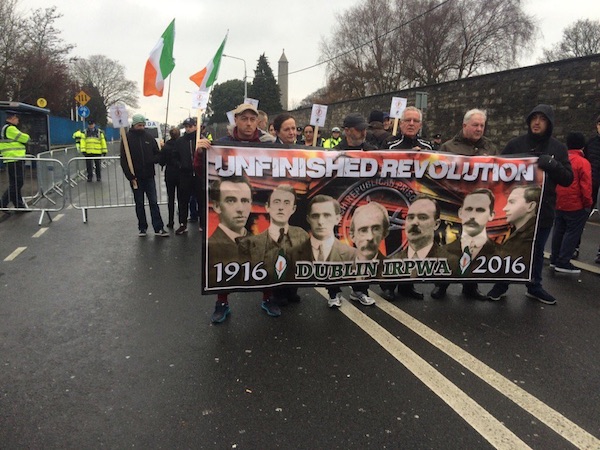
There were clashes between protesters and police at the unveiling of a 1916 Easter Rising memorial at Glasnevin cemetery in Dublin which includes British soldiers alongside the Irish rebels and civilians who died.
Over 100 protesters gathered outside the cemetery on Sunday morning from a range of republican organisations. One of the banners read: “British soldiers with our patriot dead? Not in my name.”
During the ceremony at Glasnevin, the names of 488 people known to have died in the Rising were unveiled on granite stones.
Although similar in design to the Vietnam veterans’ memorial in Washington D.C., there has been considerable public anger at the inclusion of the names of 119 British soldiers in the memorial.
British Ambassador Dominick Chilcott and Stormont Justice Minister David Ford were present along with prominent revisionists, the 26 County Minister for Arts, Heritage and the Gaeltacht, Heather Humphreys, and the former Taoiseach, John Bruton.
The suggestion of anti-Irish sentiment at the event was reinforced by a misspelling in the Gaelic words used, which saw a misplaced fada [accent] in the first word of the title inscribed on the memorial, Eiri Amach na Casca 1916.
Sinn Fein TD TD Aengus O Snodaigh criticised the inclusion of the soldiers’ names. In a statement issued prior to the ceremony, Mr O Snodaigh, who chairs Sinn Fein’s 1916 centenary committee, said his party was opposed to it.
“Sinn Fein did not agree to this proposal as we believe it is totally inappropriate for a memorial wall to list indiscriminately together Irish freedom-fighters and members of the British crown forces,” he said.
Party colleague Peadar Toibin added: “British soldiers imposing oppression through violence should not be commemorated equally with Volunteers seeking Irish freedom.”
John Green, chairman of Glasnevin Trust, claimed the wall ‘reflected modern Ireland’.
“Behind each and everyone of these lost lives is a story of heartbreak, no matter what side the person served on or indeed for those innocently caught up in the conflict,” he said.
The monument, which is also known as the ‘Necrology Wall’, is scheduled to include names of those British forces who died in the fight against Irish independence in 1919-21, including notorious war criminals from the Black and Tans and the B-Specials.
Eirigi, the socialist republican party dubbed the installation “the Tan Wall”, in reference to the auxiliary group of police and British soldiers who carried out a series of unprovoked massacres of Irish civilians.
“The Glasnevin Wall is part of a wider revisionist agenda that promotes a false narrative about 1916,” they said. “The revisionists would have us believe that 1916 was an avoidable tragedy that led to many unnecessary deaths and that there was some form of moral equality in the actions of a legitimate liberation movement and the actions of a murderous colonial regime. We reject this revisionist nonsense.”
In a commentary which also provoked anger the same day, prominent former rock musician Bob Geldof criticised the leaders of the 1916 Irish Easter Rising, and compared them to jihadi suicide bombers. The former star argued in the London-based Mail on Sunday that the leaders of the insurrection had “martyred themselves” in a bid to inspire others to take up arms.
“Clearly they knew ‘the only thing that will come out of this is that we get shot, we get to be martyrs, that’ll spur another generation,” he wrote. “What’s admirable about that, if you also don’t admire the guy who’s just walked into Pakistan and blown up 73 people at a Christian carnival in Lahore? What’s the difference?”
REDMOND COMES DOWN
However, a controversial 1916 commemorative banner, featuring three politicians who died before the Easter Rising and one who opposed the rebellion, has been removed from the Bank of Ireland building at College Green in Dublin.
The banner, depicting Henry Grattan, Daniel O’Connell, Charles Stewart Parnell and John Redmond, were a source of anger since they were erected last month. Grattan, O’Connell and Parnell were Westminster MPs who died well before the Rising, while Redmond described the Rising as a “wicked and insane” event. Last week, it was defaced by Irish language activists.
At a council meeting, Sinn Fein’s Greg Kelly, who proposed the removal of the banner, said he had the support of the majority of the council’s arts committee for its removal. Fianna Fail councillor Paul McAuliffe said the lack of a recognition of the leaders of the Rising had caused offence. “It looked like one version of history was being pushed.”
Independent Mannix Flynn said people found the banner “obnoxious” and “repellent”.
While councillors from most parties, apart from Fine Gael and Labour, spoke against the banner, they failed to vote in time on a resolution to have it taken down. The following day the council said it would stay in place for “the duration of the commemorations programme”. The programme is scheduled to continue to the end of the year.
However, on Friday morning, the council suddenly removed the banner. In a statement it said it had been a temporary arrangement.
“It was always intended that both parties would agree that they would be removed within a few weeks following the Easter weekend celebrations.”
![[Irish Republican News]](https://republican-news.org/graphics/title_gifs/rn.gif)
![[Irish Republican News]](https://republican-news.org/graphics/title_gifs/harp.gif)

